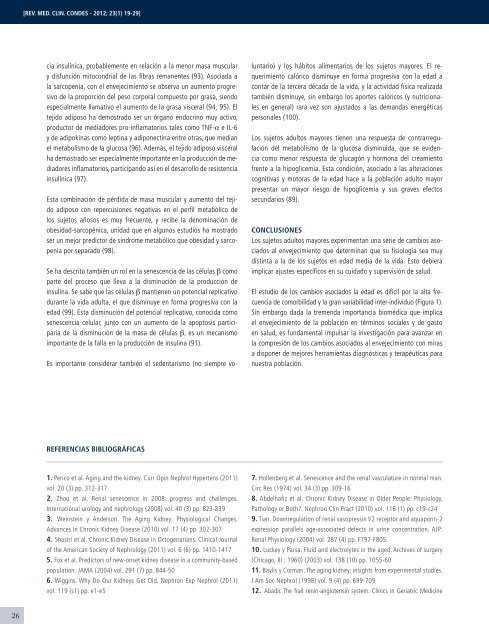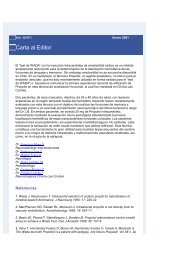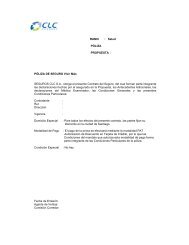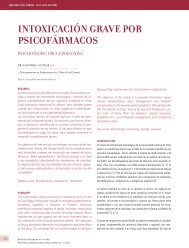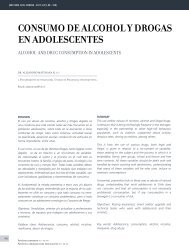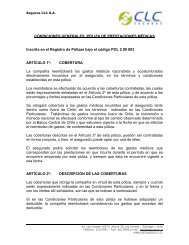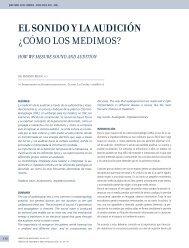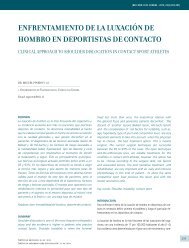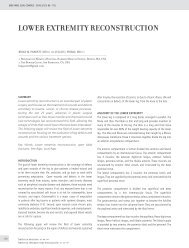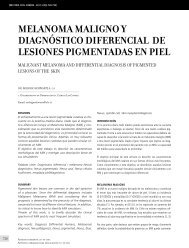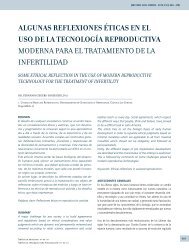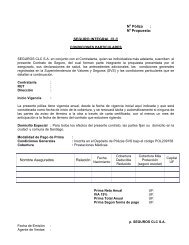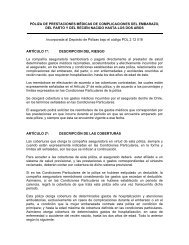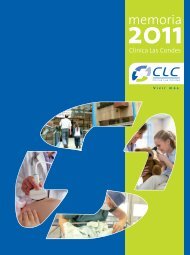Hijos adultos mayores al cuidado de sus padres, un fenómeno ...
Hijos adultos mayores al cuidado de sus padres, un fenómeno ...
Hijos adultos mayores al cuidado de sus padres, un fenómeno ...
You also want an ePaper? Increase the reach of your titles
YUMPU automatically turns print PDFs into web optimized ePapers that Google loves.
[REV. MED. CLIN. CONDES - 2012; 23(1) 19-29]<br />
cia insulínica, probablemente en relación a la menor masa muscular<br />
y disf<strong>un</strong>ción mitocondri<strong>al</strong> <strong>de</strong> las fibras remanentes (93). Asociada a<br />
la sarcopenia, con el envejecimiento se observa <strong>un</strong> aumento progresivo<br />
<strong>de</strong> la proporción <strong>de</strong>l peso corpor<strong>al</strong> compuesto por grasa, siendo<br />
especi<strong>al</strong>mente llamativo el aumento <strong>de</strong> la grasa viscer<strong>al</strong> (94, 95). El<br />
tejido adiposo ha <strong>de</strong>mostrado ser <strong>un</strong> órgano endocrino muy activo,<br />
productor <strong>de</strong> mediadores pro-inflamatorios t<strong>al</strong>es como TNF-α e IL-6<br />
y <strong>de</strong> adipokinas como leptina y adiponectina entre otras, que median<br />
el metabolismo <strong>de</strong> la glucosa (96). A<strong>de</strong>más, el tejido adiposo viscer<strong>al</strong><br />
ha <strong>de</strong>mostrado ser especi<strong>al</strong>mente importante en la producción <strong>de</strong> mediadores<br />
inflamatorios, participando así en el <strong>de</strong>sarrollo <strong>de</strong> resistencia<br />
insulínica (97).<br />
Esta combinación <strong>de</strong> pérdida <strong>de</strong> masa muscular y aumento <strong>de</strong>l tejido<br />
adiposo con repercusiones negativas en el perfil metabólico <strong>de</strong><br />
los sujetos añosos es muy frecuente, y recibe la <strong>de</strong>nominación <strong>de</strong><br />
obesidad-sarcopénica, <strong>un</strong>idad que en <strong>al</strong>g<strong>un</strong>os estudios ha mostrado<br />
ser <strong>un</strong> mejor predictor <strong>de</strong> sindrome metabólico que obesidad y sarcopenia<br />
por separado (98).<br />
Se ha <strong>de</strong>scrito también <strong>un</strong> rol en la senescencia <strong>de</strong> las células β como<br />
parte <strong>de</strong>l proceso que lleva a la disminución <strong>de</strong> la producción <strong>de</strong><br />
insulina. Se sabe que las células β mantienen <strong>un</strong> potenci<strong>al</strong> replicativo<br />
durante la vida adulta, el que disminuye en forma progresiva con la<br />
edad (99). Esta disminución <strong>de</strong>l potenci<strong>al</strong> replicativo, conocida como<br />
senescencia celular, j<strong>un</strong>to con <strong>un</strong> aumento <strong>de</strong> la apoptosis participaría<br />
<strong>de</strong> la disminución <strong>de</strong> la masa <strong>de</strong> células β, es <strong>un</strong> mecanismo<br />
importante <strong>de</strong> la f<strong>al</strong>la en la producción <strong>de</strong> insulina (91).<br />
Es importante consi<strong>de</strong>rar también el se<strong>de</strong>ntarismo (no siempre vol<strong>un</strong>tario)<br />
y los hábitos <strong>al</strong>imentarios <strong>de</strong> los sujetos <strong>mayores</strong>. El requerimiento<br />
c<strong>al</strong>órico disminuye en forma progresiva con la edad a<br />
contar <strong>de</strong> la tercera década <strong>de</strong> la vida, y la actividad física re<strong>al</strong>izada<br />
también disminuye, sin embargo los aportes c<strong>al</strong>óricos (y nutricion<strong>al</strong>es<br />
en gener<strong>al</strong>) rara vez son ajustados a las <strong>de</strong>mandas energéticas<br />
person<strong>al</strong>es (100).<br />
Los sujetos <strong>adultos</strong> <strong>mayores</strong> tienen <strong>un</strong>a respuesta <strong>de</strong> contrarregulación<br />
<strong>de</strong>l metabolismo <strong>de</strong> la glucosa disminuida, que se evi<strong>de</strong>ncia<br />
como menor respuesta <strong>de</strong> glucagón y hormona <strong>de</strong>l creamiento<br />
frente a la hipoglicemia. Esta condición, asociado a las <strong>al</strong>teraciones<br />
cognitivas y motoras <strong>de</strong> la edad hace a la población adulto mayor<br />
presentar <strong>un</strong> mayor riesgo <strong>de</strong> hipoglicemia y <strong>sus</strong> graves efectos<br />
sec<strong>un</strong>darios (89).<br />
Conclusiones<br />
Los sujetos <strong>adultos</strong> <strong>mayores</strong> experimentan <strong>un</strong>a serie <strong>de</strong> cambios asociados<br />
<strong>al</strong> envejecimiento que <strong>de</strong>terminan que su fisiología sea muy<br />
distinta a la <strong>de</strong> los sujetos en edad media <strong>de</strong> la vida. Esto <strong>de</strong>biera<br />
implicar ajustes específicos en su <strong>cuidado</strong> y supervisión <strong>de</strong> s<strong>al</strong>ud.<br />
El estudio <strong>de</strong> los cambios asociados la edad es difícil por la <strong>al</strong>ta frecuencia<br />
<strong>de</strong> comorbilidad y la gran variabilidad inter-individuo (Figura 1).<br />
Sin embargo dada la tremenda importancia biomédica que implica<br />
el envejecimiento <strong>de</strong> la población en términos soci<strong>al</strong>es y <strong>de</strong> gasto<br />
en s<strong>al</strong>ud, es f<strong>un</strong>dament<strong>al</strong> impulsar la investigación para avanzar en<br />
la compresión <strong>de</strong> los cambios asociados <strong>al</strong> envejecimiento con miras<br />
a disponer <strong>de</strong> mejores herramientas diagnósticas y terapéuticas para<br />
nuestra población.<br />
REFERENCIAS BIBLIOGRáFICAS<br />
1. Perico et <strong>al</strong>. Aging and the kidney. Curr Opin Nephrol Hypertens (2011)<br />
vol. 20 (3) pp. 312-317<br />
2. Zhou et <strong>al</strong>. Ren<strong>al</strong> senescence in 2008: progress and ch<strong>al</strong>lenges.<br />
Internation<strong>al</strong> urology and nephrology (2008) vol. 40 (3) pp. 823-839<br />
3. Weinstein y An<strong>de</strong>rson. The Aging Kidney: Physiologic<strong>al</strong> Changes.<br />
Advances in Chronic Kidney Disease (2010) vol. 17 (4) pp. 302-307<br />
4. Shastri et <strong>al</strong>. Chronic Kidney Disease in Octogenarians. Clinic<strong>al</strong> Journ<strong>al</strong><br />
of the American Society of Nephrology (2011) vol. 6 (6) pp. 1410-1417<br />
5. Fox et <strong>al</strong>. Predictors of new-onset kidney disease in a comm<strong>un</strong>ity-based<br />
population. JAMA (2004) vol. 291 (7) pp. 844-50<br />
6. Wiggins. Why Do Our Kidneys Get Old. Nephron Exp Nephrol (2011)<br />
vol. 119 (s1) pp. e1-e5<br />
7. Hollenberg et <strong>al</strong>. Senescence and the ren<strong>al</strong> vasculature in norm<strong>al</strong> man.<br />
Circ Res (1974) vol. 34 (3) pp. 309-16<br />
8. Ab<strong>de</strong>lhafiz et <strong>al</strong>. Chronic Kidney Disease in Ol<strong>de</strong>r People: Physiology,<br />
Pathology or Both?. Nephron Clin Pract (2010) vol. 116 (1) pp. c19-c24<br />
9. Tian. Downregulation of ren<strong>al</strong> vasopressin V2 receptor and aquaporin-2<br />
expression par<strong>al</strong>lels age-associated <strong>de</strong>fects in urine concentration. AJP:<br />
Ren<strong>al</strong> Physiology (2004) vol. 287 (4) pp. F797-F805<br />
10. Luckey y Parsa. Fluid and electrolytes in the aged. Archives of surgery<br />
(Chicago, Ill : 1960) (2003) vol. 138 (10) pp. 1055-60<br />
11. Baylis y Corman. The aging kidney: insights from experiment<strong>al</strong> studies.<br />
J Am Soc Nephrol (1998) vol. 9 (4) pp. 699-709<br />
12. Abadir. The frail renin-angiotensin system. Clinics in Geriatric Medicine<br />
26


